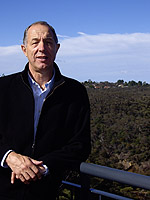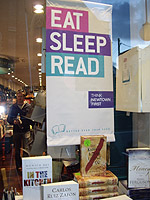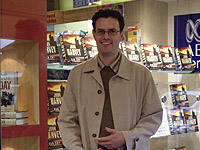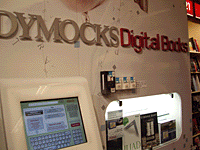Bookish Travels Down Under
By Meg Smith, ABA Chief Marketing Officer
In 1787, eleven ships left Portsmouth, England, to form a penal colony in Australia. Among the 1,480 men, women, and children and clothing and building supplies carried by the First Fleet was a notable essential for the new life ahead: a printing press. Whatever was to come, the new settlers were prepared to write and read about it.
 Derek Dryden |
I learned that prescient fact and other bits of Australian history during my recent trip Down Under, in what turned out to be a six-day crash course not only in history, but in current events, politics, language, art, and, of course, bookselling. I'd been invited as a guest of the Australian Booksellers Association (OzBA as it was being called) to deliver part of the keynote address at their recent conference, "Selling the Future of the Book," and to discuss IndieBound and its application in the Australian market. The trip was the idea of Derek Dryden, immediate past president of OzBA and owner of Better Read Than Dead, located in a suburb of Sydney; incoming president Jon Page, general manager of Pages and Pages, also in Sydney; and current president Fiona Stager of Avid Reader in Brisbane. Derek and Fiona have attended much of ABA's educational programming in the last few years and were excited to explore ways of importing IndieBound. So at BookExpo America 2009, the plan was hatched. Two weeks later, with jet-lag herbal supplements in hand, I was on a plane to Australia, a place I'd never been, and was thrilled to be going.
Derek was my main scheduler and tour guide, and he undertook the task with an easiness and charm that epitomized the Aussie booksellers and publishers to whom he introduced me. And introduce me he did: within my first hours in Sydney I was meeting with Jan Campbell, the Sydney Economic Development officer to discuss a shop local plan for the Newtown section, and in the next hours I visited no less than eight bookshops (no "stores" there, just the more elegant "shops") and met just as many owners or managers. As we went, I quizzed Derek on their ways of the trade. We talked about the "GFC" (Australia's cozy acronym for the global financial crisis) and its impact on bookselling, as well as the price competition from the "DDS" (discount department stores). I learned about their pressing issues of territorial copyright and the parallel importation of books, and how a government inquiry by the Australian Productivity Commission might result in cheaper prices for books at the peril of local publishers and booksellers.
We also talked about his ABA and my ABA, and the similarities and differences between them -- most notably that OzBA is comprised of chains and indies -- 44 percent indies and 35 percent chains -- and the chain members are either company-owned stores or franchisees. A very different model, indeed.
 We visited chain stores (Dymocks), indies in the downtown business center (Abbeys) and indies in the surrounding suburbs (including Shearer's). Derek saved the visit to his Better Read Than Dead, in the Newtown section of Sydney, for last. And he had a surprise waiting for me there: the two front windows were decorated with Eat Sleep Read banners, in his store colors, and tagged with "Think Newtown First." What a thrill to see the movement gone global!
We visited chain stores (Dymocks), indies in the downtown business center (Abbeys) and indies in the surrounding suburbs (including Shearer's). Derek saved the visit to his Better Read Than Dead, in the Newtown section of Sydney, for last. And he had a surprise waiting for me there: the two front windows were decorated with Eat Sleep Read banners, in his store colors, and tagged with "Think Newtown First." What a thrill to see the movement gone global!
 Jon Page |
Over the course of my store visits with Derek, and again the next day, as Jon Page took over and escorted me to four additional shops, I was struck by how crowded with customers the stores were and how brisk business seemed. The shops I saw were not large -- the average Australian indie shop is maybe 1,500 to 3,000 square feet -- but the independent bookshops represent a solid 20 percent of the overall book market.
 Sydney seems to be made up of lots of adjoining communities with vibrant Main Streets, strips of mostly small, indie-looking businesses and lots of foot traffic. And what I saw, it turns out, is typical -- Australia has the highest number of book buyers (and opera goers!) per capita in the world. New Zealand has the highest number of bookshops per capita in the world, and Australia is fourth in that category. The entire scale of the business differs from the U.S. For example, booksellers earn more in Oz than in the U.S. -- salaries, which are dictated by the government, average $20/hour ($16 U.S.) and can go as high as $40/hour on holidays and weekends. Hardcover books cost close to $50 Australian (about $40 U.S.) and paperbacks are around $35 AU.
Sydney seems to be made up of lots of adjoining communities with vibrant Main Streets, strips of mostly small, indie-looking businesses and lots of foot traffic. And what I saw, it turns out, is typical -- Australia has the highest number of book buyers (and opera goers!) per capita in the world. New Zealand has the highest number of bookshops per capita in the world, and Australia is fourth in that category. The entire scale of the business differs from the U.S. For example, booksellers earn more in Oz than in the U.S. -- salaries, which are dictated by the government, average $20/hour ($16 U.S.) and can go as high as $40/hour on holidays and weekends. Hardcover books cost close to $50 Australian (about $40 U.S.) and paperbacks are around $35 AU.
I asked each bookseller I met what one book they would recommend that I wouldn't be able to find anywhere else. Tony at Shearer's did a great handsell of The Last Explorer, the story of Hubert Wilkins, "Australia's Unknown Hero," by Simon Nasht; Jon Page sold me the YA novel Jasper Jones, by Craig Silvey; and David Gaunt, from GleeBooks in Glebe, passionately recommended as the quintessential Australian tale The Tall Man, a story about the death of an Aboriginal man, by Chloe Hooper. Derek recommended The Slap ("of course!") by Christos Tsolkas, published by Aussie indie publisher Allen and Unwin. This last book, which I hadn't heard of prior to this trip, went on to win three prizes during my stay, and I had the pleasure of being present for each announcement. I now can't wait to read it. (I'd brought with me another Aussie award-winner, Breath by Tim Winton, thanks to my well-read ABA colleague Mark Nichols!)
After two days of visits to various stores in far-flung Sydney suburbs, it was time for the "Selling the Future of the Book" conference to begin. Lucky for me, the event was held in Manly, a short ferry-ride from the Sydney harbor and home of one of those famous Australian beaches. Although it is winter Down Under, the temperature on sunny days reached the mid-sixties, and the surfers were out regardless. The light in Manly is other worldly, and the lack of pollution results in a clarity not experienced on our side of the map. (Clarity can have deadly results: Australians have the highest rate of skin cancer in the world, and schoolchildren must wear wide-brimmed hats as part of their standard uniforms.)
The conference, true to its name, focused on the future of the book. (You can see the program here: I was a late addition and thus not included in this schedule.) As the first live speaker, I gave an overview of the current U.S. book and publishing scenes, talked about the mission of ABA, and then moved on to independent retail and the IndieBound movement and its resources. The attendees -- both booksellers and publishers -- were amazed and impressed by IndieBound. (People came up to me constantly over the next few days to comment on the program, to congratulate ABA on our vision, and to ask how they could get hold of some of the materials!)
Subsequent speakers of note included David Taylor of Ingram's Lightning Source, who gave a great overview of POD; Neelan Choski of Stanza, who neatly summarized the chaos that is e-Books; a rep from Nielsen BookScan, who gave a detailed bestseller data analysis for Australia, the U.K., and the U.S.; and booksellers David Gaunt and Susie Wilson, who reported on the national Indigenous Literacy Project.
A big topic at the conference's open forums was e-books, which are just now entering the Australian market in the smallest way, and without the Kindle or a significant Amazon presence. The Aussie indie booksellers, who see the DDS (discount department stores) rather than the chains or the Internet as their biggest threat, are by and large quite open to the notion of e-books and mobile reading -- whatever the format, delivery, or device. They view it as an opportunity to interest more people in reading, in buying books, and in shopping at their local retailer for recommendations and guidance. They were quite interested in our ABA digital strategy and are watching the U.S. market closely for the dominant players in all aspects to emerge.
As the Australian book trade is smaller than the U.S., and most publishers are located in Sydney, I had the opportunity to meet the heads of all the major global and local publishing houses over the course of the conference events. That printing press brought over by the First Fleet's Golden Grove was the beginning of an active and vital Australian publishing scene. Australian writers are abundant, are often published overseas, and are fiercely promoted at home. The expression "punching above their weight" was often used to refer to the position of Australian writers and publishers in the rest of the English-speaking world.
One of the best loved of Australian writers and wits, Don Watson (Death Sentences) spoke wonderfully at the concluding bookseller dinner, and this Anglophile-cum-Aussie-enthusiast was delighted by it all. That 85th annual booksellers dinner, which included the presentation of the Booksellers Choice Award to Tsolkas for The Slap, also introduced me to the custom of the "Australian wedding": traditionally, men were served meat and woman chicken, and so even now there are two choices for each of the appetizers, main course, and dessert, but not at the guests' option. You are expected to negotiate with your tablemates for the food of your choice! And if everyone wants chocolate pudding for dessert? Well, just don't ask the waiter for extras!
The trip was capped by one more awards ceremony: the ABIAs, the Australian Book Industry Awards. This annual event, sponsored by the Australian Publishers Association, brings together publishers, booksellers, and authors in grand style to celebrate the best in books and industry players. Derek had told me the ABIAs were their "book Oscars" and it was. The only thing missing was the red carpet spectacle.
I had time for a drive to the gorgeous Blue Mountains and then, too soon, was back on a plane for the long journey home.
Over the next few weeks I and my colleagues at ABA expect to follow up with both Malcolm Neil, the CEO of OzBA, and Lincoln Gould, the CEO of Booksellers New Zealand, about how, what, and when we might develop partnerships for IndieBound and other ABA programs. Both groups are anxious to, in their words, "not reinvent the wheel" that ABA has so carefully begun to build.


